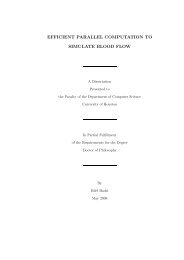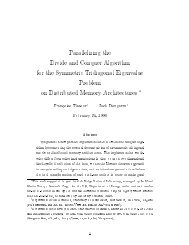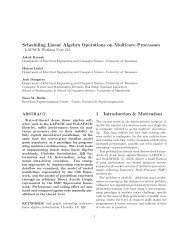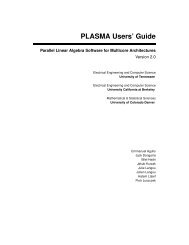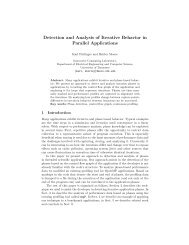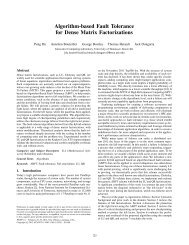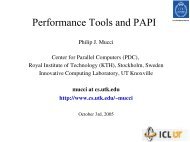Fast and Small Short Vector SIMD Matrix Multiplication ... - The Netlib
Fast and Small Short Vector SIMD Matrix Multiplication ... - The Netlib
Fast and Small Short Vector SIMD Matrix Multiplication ... - The Netlib
Create successful ePaper yourself
Turn your PDF publications into a flip-book with our unique Google optimized e-Paper software.
It should be quite obvious that the Local Store is<br />
a scarse resource <strong>and</strong> any real-world application is<br />
facing the problem of fitting tightly coupled components<br />
together in the limited space. SPE code can<br />
be replaced at runtime <strong>and</strong> the mechanism of overlays<br />
[34] can be of assistance with dynamic code<br />
management. Nevertheless, the use of kernels of<br />
tens of thous<strong>and</strong>s of kilobytes in size (§3) does not<br />
seem adequate for other purposes than to implement<br />
micro-benchmarks.<br />
3 Related Work<br />
Little literature exists about implementing matrix operations<br />
using short-vector <strong>SIMD</strong> capabilities. Implementation<br />
of matrix multiplication C = C + A × B T<br />
using Intel Streaming <strong>SIMD</strong> Extensions (SSE) was<br />
reported by Aberdeen <strong>and</strong> Baxter [35].<br />
Analysis of performance considerations of various<br />
computational kernels for the CELL processor,<br />
including the GEMM kernel, was presented by<br />
Williams et al. [36, 37], with results based mostly on<br />
simulation.<br />
<strong>The</strong> first implementation of the matrix multiplication<br />
kernel C = A × B for the CELL processor<br />
was reported by Chen et al. [22]. Performance of<br />
25.01 Gflop/s was reported on a single SPE with register<br />
usage of 69. Presumably, the article describes<br />
the C language implementation publicly distributed<br />
with the IBM CELL SDK.<br />
More recently assembly language implementation<br />
of the matrix multiplication C = C − A × B was<br />
reported by Hackenberg[25, 26]. Performance of<br />
25.40 Gflop/s was reported. Register usage of 71<br />
can be established by inspection of the publicly available<br />
code.<br />
Both codes were developed using very aggressive<br />
unrolling, resulting in a single loop with a huge<br />
body of straight-line code. <strong>Multiplication</strong> of 64 × 64<br />
matrices requires 64 × 64 × 64 = 262144 multiplications<br />
<strong>and</strong> additions (or subtractions). In single<br />
precision, the calculation can be implemented by<br />
262144/4 = 65536 fused multiply-add (FMA) <strong>SIMD</strong><br />
operations or fused multiply-subtract (FNMS) <strong>SIMD</strong><br />
operations. Both codes place 4096 of these operations<br />
in the body of a loop, which iterates 16 times<br />
<strong>and</strong> results in the size of the first code of roughly<br />
32 KB <strong>and</strong> the size of the second one close to 26 KB.<br />
Since the first code is in C, the exact size is compiler<br />
dependent.<br />
CELL BLAS library released as part of the<br />
SDK 3.0 [38] includes an SPE SGEMM kernel for<br />
multiplication of 64 × 64 martices. <strong>The</strong> routine is not<br />
available in source form. <strong>The</strong> size of the object code<br />
is over 32 KB.<br />
4 Original Contribution<br />
In this publication, an implementation of the GEMM<br />
kernel C = C −A×B T is reported, which, to the best<br />
knowledge of the authors, has not been reported before.<br />
Also, an implementation of the GEMM kernel<br />
C = C − A × B is reported, which achieves better<br />
performance than the kernels reported before, <strong>and</strong><br />
at the same time occupies more than four times less<br />
space. It is also shown that the latter kernel is optimal,<br />
in the sense that neither performance can be<br />
further improved nor code size decreased.<br />
It is also the intention of the authors to demystify<br />
the topic by clearly explaining the careful analysis<br />
behind optimized implementation of computational<br />
micro-kernels exploiting <strong>SIMD</strong> ILP, VLIW-like,<br />
dual-issue <strong>and</strong> other low-level architectural features<br />
of the computational cores of the CELL processor.<br />
5 Implementation<br />
5.1 SPU Architecture Overview<br />
<strong>The</strong> core of the SPE is the Synergistic Processing<br />
Unit (SPU). <strong>The</strong> SPU [39–41] is a RISC-style<br />
<strong>SIMD</strong> processor feturing 128 general purpose registers<br />
<strong>and</strong> 32-bit fixed length instruction encoding.<br />
SPU includes instructions that perform single precision<br />
floating point, integer arithmetic, logicals, loads,<br />
stores, compares <strong>and</strong> branches. SPU includes nine<br />
execution units organized into two pipelines, referred<br />
3



